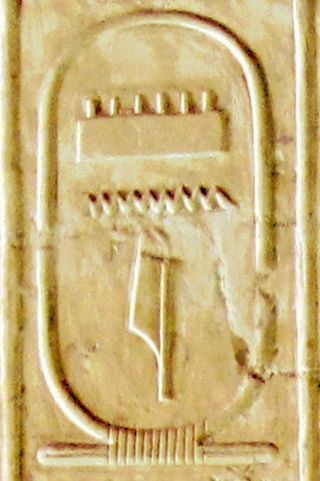
Menes was a pharaoh of the Early Dynastic Period of ancient Egypt, credited by classical tradition with having united Upper and Lower Egypt, and as the founder of the First Dynasty.

Narmer was an ancient Egyptian pharaoh of the Early Dynastic Period, whose reign began at a date estimated to fall in the range 3273–2987 BC. He was the successor to the Protodynastic king Ka. Many scholars consider him the unifier of Egypt and founder of the First Dynasty, and in turn the first king of a unified Egypt. He also had a prominently noticeable presence in Canaan, compared to his predecessors and successors. Neithhotep is thought to be his queen consort or his daughter.

The Narmer Palette, also known as the Great Hierakonpolis Palette or the Palette of Narmer, is a significant Egyptian archaeological find, dating from about the 31st century BC, belonging, at least nominally, to the category of cosmetic palettes. It contains some of the earliest hieroglyphic inscriptions ever found. The tablet is thought by some to depict the unification of Upper and Lower Egypt under the king Narmer. Along with the Scorpion Macehead and the Narmer Maceheads, also found together in the main deposit at Nekhen, the Narmer Palette provides one of the earliest known depictions of an Egyptian king. On one side, the king is depicted with the bulbed White Crown of Upper (southern) Egypt, and the other side depicts the king wearing the level Red Crown of Lower (northern) Egypt, which also makes it the earliest known example of a king wearing both types of headdress. The Palette shows many of the classic conventions of Ancient Egyptian art, which must already have been formalized by the time of the Palette's creation. Egyptologists Bob Brier and A. Hoyt Hobbs have referred to the Narmer Palette as "The oldest Egyption historical record".

Nekhen, also known as Hierakonpolis was the religious and political capital of Upper Egypt at the end of prehistoric Egypt and probably also during the Early Dynastic Period.
The Early Dynastic Period, also known as Archaic Period or the Thinite Period, is the era of ancient Egypt that immediately follows the unification of Upper and Lower Egypt in c. 3150 BC. It is generally taken to include the First Dynasty and the Second Dynasty, lasting from the end of the archaeological culture of Naqada III until c. 2686 BC, or the beginning of the Old Kingdom. With the First Dynasty, the Egyptian capital moved from Thinis to Memphis, with the unified land being ruled by an Egyptian god-king. In the south, Abydos remained the major centre of ancient Egyptian religion; the hallmarks of ancient Egyptian civilization, such as Egyptian art, Egyptian architecture, and many aspects of Egyptian religion, took shape during the Early Dynastic Period.

Hor-Aha is considered the second pharaoh of the First Dynasty of Egypt by some Egyptologists, while others consider him the first one and corresponding to Menes. He lived around the 31st century BC and is thought to have had a long reign.

Prehistoric Egypt and Predynastic Egypt was the period of time starting at the first human settlement and ending at the First Dynasty of Egypt around 3100 BC.

Scorpion II, also known as King Scorpion, was a ruler during the Protodynastic Period of Upper Egypt.

Deshret was the Red Crown of Lower Egypt. When combined with the Hedjet of Upper Egypt, it forms the Pschent, in ancient Egyptian called the sekhemti.

Hedjet is the White Crown of pharaonic Upper Egypt. After the unification of Upper and Lower Egypt, it was combined with the Deshret, the Red Crown of Lower Egypt, to form the Pschent, the double crown of Egypt. The symbol sometimes used for the White Crown was the vulture goddess Nekhbet shown next to the head of the cobra goddess Wadjet, the uraeus on the Pschent.
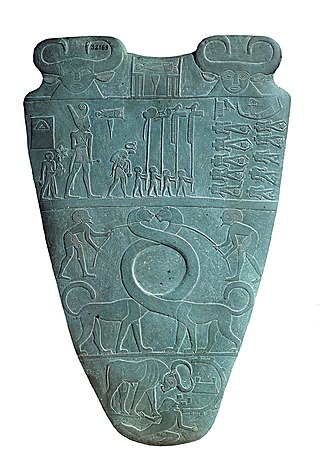
Naqada III is the last phase of the Naqada culture of ancient Egyptian prehistory, dating from approximately 3200 to 3000 BC. It is the period during which the process of state formation, which began in Naqada II, became highly visible, with named kings heading powerful polities. Naqada III is often referred to as Dynasty 0 or the Protodynastic Period to reflect the presence of kings at the head of influential states, although, in fact, the kings involved would not have been a part of a dynasty. In this period, those kings' names were inscribed in the form of serekhs on a variety of surfaces including pottery and tombs.
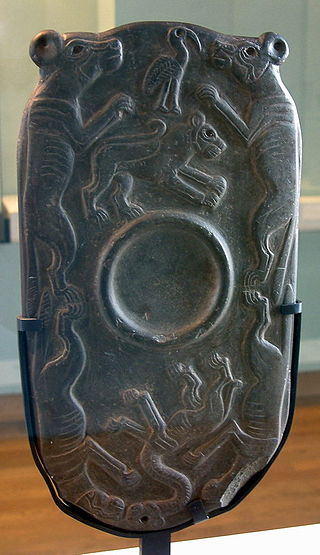
Cosmetic palettes are archaeological artifacts, originally used in predynastic Egypt to grind and apply ingredients for facial or body cosmetics. The decorative palettes of the late 4th millennium BCE appear to have lost this function and became commemorative, ornamental, and possibly ceremonial. They were made almost exclusively out of siltstone with a few exceptions. The siltstone originated from quarries in the Wadi Hammamat.
The Amratian culture, also called Naqada I, was an archaeological culture of prehistoric Upper Egypt. It lasted approximately from 4000 to 3500 BC.
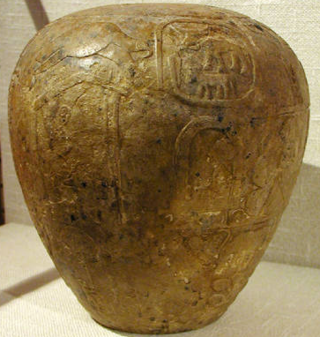
The Narmer macehead is an ancient Egyptian decorative stone mace head. It was found in the "main deposit" in the temple area of the ancient Egyptian city of Nekhen (Hierakonpolis) by James Quibell in 1898. It is dated to the Early Dynastic Period reign of king Narmer whose serekh is engraved on it. The macehead is now kept at the Ashmolean Museum, Oxford.

The Gebel el-Arak Knife, also Jebel el-Arak Knife, is an ivory and flint knife dating from the Naqada II period of Egyptian prehistory, showing Mesopotamian influence. The knife was purchased in 1914 in Cairo by Georges Aaron Bénédite for the Louvre, where it is now on display in the Sully wing, room 633. At the time of its purchase, the knife handle was alleged by the seller to have been found at the site of Gebel el-Arak, but it is today believed to come from Abydos.
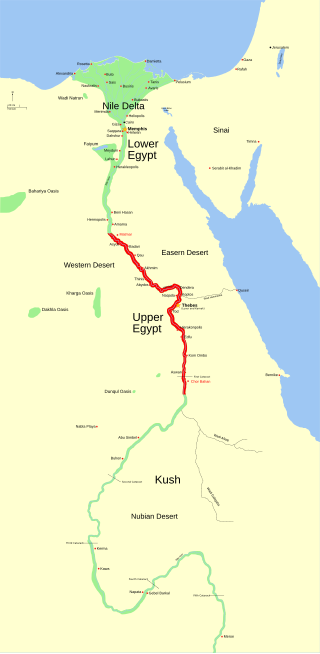
The Naqada culture is an archaeological culture of Chalcolithic Predynastic Egypt, named for the town of Naqada, Qena Governorate. A 2013 Oxford University radiocarbon dating study of the Predynastic period suggests a beginning date sometime between 3,800 and 3,700 BC.

Double Falcon was a ruler of Lower Egypt from Naqada III. He may have reigned during the 32nd century BC. The length of his reign is unknown.
Minshat Abu Omar is an important archaeological site in Northern Egypt. It lies around 93.21 miles north-east of Cairo in the Nile delta. Minshat Abu Omar contains several cemeteries from protodynastic dynasties, as well as many burial sites that date back to the late Roman Era.

Egypt–Mesopotamia relations were the relations between the civilizations of ancient Egypt and Mesopotamia, in the Middle East. They seem to have developed from the 4th millennium BCE, starting in the Uruk period for Mesopotamia and the half a millennium younger Gerzean culture of Prehistoric Egypt, and constituted a largely one way body of influences from Mesopotamia into Egypt.














